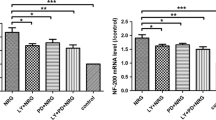Abstract
Aminopyridines, widely used as a K+ channel blocker, are membrane-permeable weak bases and have the ability to form vacuoles in the cytoplasm. The vacuoles originate from acidic organelles such as lysosomes. Here, we investigated the effects of 4-aminopyridine (4-AP) on organelle movement in neurites of cultured mouse dorsal root ganglion (DRG) neurons by using video-enhanced microscopy. Some experiments were carried out using fluorescent dyes for lysosomes and mitochondria and confocal microscopy. Treatment of DRG neurons with 4 mM 4-AP caused Brownian movement of some lysosomes within 5 min. The Brownian movement gradually became rapid and vacuoles were formed around individual lysosomes 10–20 min after the start of treatment. Axonal transport of organelles was inhibited by 4-AP. Lysosomes showing Brownian movement were not transported in longitudinal direction of the neurite and the transport of mitochondria was interrupted by vacuoles. The 4-AP-induced Brownian movement of lysosomes with vacuole formation and inhibition of axonal transport were prevented by the simultaneous treatment with vacuolar H+ ATPase inhibitor bafilomycin A1 or in Cl−-free SO 2−4 medium. These results indicate that changes in organelle movement by 4-AP are related to vacuole formation and the vacuolar H+ ATPase and Cl− are required for the effects of 4-AP.




Similar content being viewed by others
Abbreviations
- 4-AP:
-
4-aminopyridine
- DRG:
-
dorsal root ganglion
- PSS:
-
physiological salt solution
- SD:
-
standard deviation
References
Alfonso, A., Cabado, A. G., Vieytes, M. R., & Botana, L. M. (2000). Calcium-pH crosstalks in rat mast cells: Cytosolic alkalinization, but not intracellular calcium release, is a sufficient signal for degranulation. British Journal of Pharmacology, 130, 1809–1816.
Alvarez-Leefmans, F. J., Gamiño, S. M., Giraldez, F., & Noguerón, I. (1988). Intracellular chloride regulation in amphibian dorsal root ganglion neurones studied with ion-selective microelectrodes. The Journal of Physiology, 406, 225–246.
Arai, K., Yasuda, N., Isohashi, F., Okamoto, K., & Ohkuma, S. (2002). Inhibition of weak-base amine-induced lysis of lysosomes by cytosol. Journal of Biochemistry, 132, 529–534.
Beyenbach, K. W., & Wieczorek, H. (2006). The V-type H+ ATPase: Molecular structure and function, physiological roles and regulation. The Journal of Experimental Biology, 209, 577–589.
Cover, T. L., Reddy, L. Y., & Blaser, M. J. (1993). Effects of ATPase inhibitors on the response of HeLa cells to Helicobacter pylori vacuolating toxin. Infection and Immunity, 61, 1427–1431.
Davis, S. G., & Lyerla, T. A. (1997). The effect of lysosomotropic amines on beige mouse cells. Experimental Cell Research, 237, 242–245.
Giglione, C., & Gross, J. D. (1995). Anion effects on vesicle acidification in Dictyostelium. Biochemistry and Molecular Biology International, 36, 1057–1065.
Henics, T., & Wheatley, D. N. (1997). Vacuolar cytoplasmic phase separation in cultured mammalian cells involves the microfilament network and reduces motional properties of intracellular water. International Journal of Experimental Pathology, 78, 343–354.
Henics, T., & Wheatley, D. N. (1999). Cytoplasmic vacuolation, adaptation and cell death: A view on new perspectives and features. Biology of the Cell, 91, 485–498.
Hilden, S. A., Johns, C. A., & Madias, N. E. (1988). Cl-dependent ATP-driven H+transport in rabbit renal cortical endosomes. The American Journal of Physiology, 255, F885–F897.
Ishihara, Y., Sakurai, T., Kimura, T., & Terakawa, S. (2000). Exocytosis and movement of zymogen granules observed by VEC-DIC microscopy in the pancreatic tissue en bloc. American Journal of physiology. Cell physiology, 279, C1177–C1188.
Lamarca, M. V., & Collier, B. (1983). Effects of 4-aminopyridine on the cat superior cervical ganglion. The Journal of Pharmacology and Experimental Therapeutics, 226, 249–257.
Mundorf, M. L., Hochstetler, S. E., & Wightman, R. M. (1999). Amine weak bases disrupt vesicular storage and promote exocytosis in chromaffin cells. Journal of Neurochemistry, 73, 2397–2405.
Normann, T. C. (1974). Calcium-dependence of neurosecretion by exocytosis. The Journal of Experimental Biology, 61, 401–409.
Ohkuma, S., & Poole, B. (1981). Cytoplasmic vacuolation of mouse peritoneal macrophages and the uptake into lysosomes of weakly basic substances. The Journal of Cell Biology, 90, 656–664.
Ohkuma, S., & Takano, T. (1997). ATP-dependent lysis of isolated lysosomes by basic substances and acidic ionophores. Cell Structure and Function, 22, 253–268.
Seglen, P. O., & Reith, A. (1976). Ammonia inhibition of protein degradation in isolated rat hepatocytes. Quantitative ultrastructural alterations in the lysosomal system. Experimental Cell Research, 100, 276–280.
Storm, J. F. (1987). Action potential repolarization and a fast after-hyperpolarization in rat hippocampal pyramidal cells. The Journal of Physiology, 385, 733–759.
Szente, M., & Baranyi, A. (1987). Mechanism of aminopyridine-induced ictal seizure activity in the cat neocortex. Brain Research, 413, 368–373.
Tapia, R., & Sitges, M. (1982). Effect of 4-aminopyridine on transmitter release in synaptosomes. Brain Research, 250, 291–299.
Wada, Y., Ohsumi, Y., & Anraku, Y. (1992). Chloride transport of yeast vacuolar membrane vesicles: A study of in vitro vacuolar acidification. Biochimica et Biophysica Acta, 1101, 296–302.
Wang, X. Q., Xiao, A. Y., Yang, A., LaRose, L., Wei, L., & Yu, S. P. (2003). Block of Na+, K+-ATPase and induction of hybrid death by 4-aminopyridine in cultured cortical neurons. The Journal of pharmacology and experimental therapeutics, 305, 502–506.
Yang, W. C. T., Strasser, F. F., & Pomerat, C. M. (1965). Mechanism of drug-induced vacuolation in tissue culture. Experimental Cell Research, 38, 495–506.
Acknowledgments
This work was partly supported by a Grand-in-Aid for Scientific Research (C) (KAKENHI 15500245) from the Japan Society for the Promotion of Science (JSPS) to H.H.
Author information
Authors and Affiliations
Corresponding author
Rights and permissions
About this article
Cite this article
Hiruma, H., Kawakami, T. Effects of 4-Aminopyridine on Organelle Movement in Cultured Mouse Dorsal Root Ganglion Neurites. J Mol Neurosci 40, 295–302 (2010). https://doi.org/10.1007/s12031-009-9219-2
Received:
Accepted:
Published:
Issue Date:
DOI: https://doi.org/10.1007/s12031-009-9219-2




